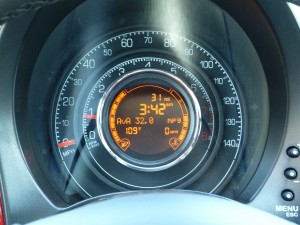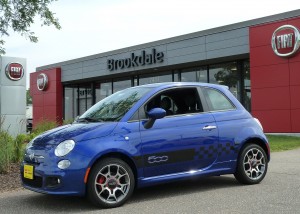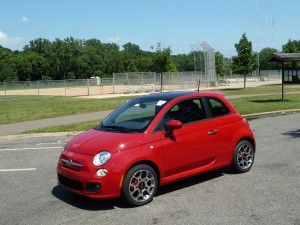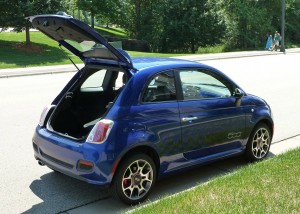Fiat 500 more fun than bowl of jellybeans
By John Gilbert
When you drive into the parking lot at, say, Rudy Luther’s Fiat in Brooklyn Park, you see about an acre of new Fiat 500 subcompacts, lined up in orderly lines so they won’t be mistaken for a gigantic bowlful of jellybeans. All the same shape, and all different colors.
Well, some are the same color, but with 14 colors available, there isn’t a lot of duplication. And an endless list of different graphics and striping packages can individualize any of the three Fiat 500 models. As I gazed down the row of new 500s at Brookdale Fiat, the claim of a half-million possible different color and graphics combinations seemed realistic. If everybody on your block bought a Fiat 500, it would be an amazing coincidence if two of them were identical.
Fiat, of course, would be very happy if everybody on your block bought a 500, which is the modern interpretation of the traditional Fiat Cinquecento. The timing is perfect, with Fiat taking over operation of Chrysler Group, and seizing the opportunity to return to the U.S. market by upgrading all Dodge, Chrysler and Jeep models, and also supplying the small car the Chrysler Group has lacked since abandoning the Neon — during which time small cars have become hugely popular.
I had a chance for a brief road test of various models at the introduction of the 500, and I appreciated a more recent invitation from Doreen Fischer, manager at Brookdale Fiat, located on Brooklyn Boulevard, just north of Interstate 694, and part of the Rudy Luther collection of dealerships. Luther’s also is operating a second Fiat outlet to be positioned in Bloomington, giving Minnesota two of the 130 U.S. dealerships — which Fiat calls “studios.†Fischer said her dealership opened April 1, and sold 21 cars in its first six weeks, long before it could build up the current supply of jellybeans.
The original Fiat Cinquecento hit the streets of Italy in 1957, a tiny little thing with rear-wheel drive that was an Italian answer to Germany’s Volkswagen Beetle. In 2009, after VW had brought back the Beetle and Mini Cooper the new Mini, Fiat decided to reconstruct its iconic small car. Making it more substantial and a bit larger, and with front-wheel drive, Fiat designers wanted to salvage the lines from the original car, notably the hood shape, windshield angle, and its angular slope to the rear.
The personalization of the 500 is an important element, according to Roberto Giolito, Head of Fiat Design, who said: “It is computer aided, but not designed by a computer. It was designed by people.â€
As the new owner of Chrysler Group, Fiat has wanted for years to return to the U.S. market, but never quite got it together. When General Motors and Chrysler needed U.S. government bailout loans to stay solvent a few years ago, the big headlines have been how GM has recovered, and how Ford has thrived without needing government help. Fiat’s takeover of the Chrysler Group — Chrysler, Dodge and Jeep — has been more subtle, but no less important.
Fiat’s redesign of all the interiors and most of the exteriors of all the Chrysler Brand vehicles for 2012 has gained justifiable praise, and Fiat has made an interesting maneuver to solve Chrysler’s lack of a small car with the Fiat 500. Curiously, perhaps, Fiat has insisted that separate that its dealers sell the 500 from separate facilities rather than being parked in a corner of a Dodge or Chrysler dealership. But make no mistake. “We are the small-car brand of Chrysler Group,†said Laura Soave, who is officially identified as the Head of Fiat Brand North America.
From the start, the car was planned to be international, with the United States one of its targets. The U.S. model has several variations from the European car, to meet more stringent safety tests and U.S. driving habits. Alterations include moving the high beams up to the main headlight enclosure, adding a modern automatic transmission, and such amenities as armrests, heated seats, cruise control, and electronic device connectivity, plus acoustic improvements to isolate engine vibration, and a new rear axle for improved ride and comfort.
Chief engineer Fabio DiMuro explained all the changes, and said: “The U.S. car came out so good, we would like to bring these features back to Europe.â€
The 500 comes in three versions for varying lifestyles. The Pop has a 5-speed manual shifter, seven airbags, and a starting price of $15,500. The Sport has a different fascia, firmer suspension settings and seats, 16-inch wheels, a starting price of $17,500, and the availability of a 6-speed automatic transmission with steering wheel paddle shifters, or the 5-sped stick. The Lounge is the top of the line, starting at $19,500, loaded up with all the features that are options on the other models, including the automatic. Some have sunroofs, and a slick-folding convertible is also available.

With the tachometer positioned inside the speedometer, also displayed was the July temperature of 109 in Minneapolis.
Fiat is aiming the 500 for an emotional connection with its owners, and if its ultra-cute styling doesn’t grab you, the interior might. A large panel of a smooth, exterior-colored panel cuts an impressive swath from left to right across the dashboard, and the instruments include a cleverly concentric speedometer outlined by the tachometer, with its second readout arrowhead and a digital speed listed in the center. Its surprisingly good performance and handling might surprise someone who hasn’t climbed inside such a well-designed subcompact recently.
The car’s light weight — 2,363 pounds for the stick and 2,434 for the automatic — means the small, 1.4-liter engine’s power pushes the 500 around very well, and amplifies the car’s agility. The actual numbers seem paltry, with only 101 horsepower, peaking at 6,500 RPMs, and 98 foot-pounds of torque, at 4,000 RPMs, but performance is better than the numbers imply and the 500 feels quick around town, and smooth while sustaining 70 or even 75 on a freeway trip. The 500 has enough high-strength steel and design reinforcements to become the first “A†segment car to attain five-star crash test ratings.
The reaction of other drivers on the freeway is interesting, because you can’t tell whether the slower vehicles you just passed have sped up and re-passed because they want a closer look at the Fiat, or whether it’s the usual American tendency to over-react to avoid feeling slighted by a subcompact zipping past so easily.
Some people recall the last Fiats that came into the U.S. There was the 124 roadster and coupe that were fun and fashionable, and the 128 subcompact that had front-wheel drive and performed quite well. For those who don’t think those mid-1960s Fiats were world-beaters, they need only to think back to the ill-handling and poorly coordinated but larger U.S. cars of that era. Since leaving the U.S. scene, Fiat’s expanding reach has taken over ownership of several other brands, including Ferrari and Alfa Romeo. It shares technology and engineering discussions with engineers from all its brands.
A perfect example is the 500‘s “MultiAir†engine, which uses technology that was patented by Fiat after being developed and then discussed with Ferrari’s Formula 1 engineers, and was then fully developed and patented by Fiat engineers. It goes beyond the sophistication of dual-overhead camshaft valve actuation.
MultiAir uses an electro-hydraulic system, with solenoids controlling oil pressure forced from the conventionally operated exhaust valves camshaft, to open and close the intake valves on a fully variable basis, depending on needs initiated by the driver. Instead of being dependent on an intake-valve camshaft, with MultiAir the intake valves can be advanced or delayed in accepting fuel-air mixture, providing a 50-percent increase in low-end torque, while also gaining a 10 percent increase in fuel efficiency and 10 percent reduction in CO2 exhaust emissions, compared to conventional engines.
We attained from 31 to 34 miles per gallon in various driving combinations, while Fiat claims 38 mpg for sustained freeway cruising with the manual transmission.
The future is indeed bright for the Fiat-Chrysler connection, because the MultiAir technique can be applied to any engine. In fact, Fiat has tested the 1.4 engine with the MultiAir system replacing both intake and exhaust valve camshafts, but found that applying the technique to the exhaust side had minimal added improvement, compared to the expense and complexity involved.
“In the 27 years Fiat has been out of the country, an amazing number of people have stories and memories keeping the name alive,†said Soave, during the car’s introductory session. “We are experts at making small cars, and in this era of diversity, we have a global icon with the 500. In America, the old philosophy is bigger is better. But whether it’s telephones or computers, everything keeps getting smaller. So we put all of the features of a large car into a smaller package. It’s not how big your car is, it’s how big your life is.â€
The small car market is expected to expand to 900,000 this year, and the best catch-phrase is that small cars are big these days. Among the dozens of small cars, only a few have a real personality. The Fiat 500 has personality aplenty, along with its Italian flair for style, and its performance and features make it an inexpensive way to drive off into the future.
Pass the jellybeans, please.
Comments
One Comment on Fiat 500 more fun than bowl of jellybeans
-
Fields Fiat – Auto Wallpaper on
Sun, 29th Mar 2020 4:38 am
[…] Download Image More @ newcarpicks.com […]
Tell me what you're thinking...
and oh, if you want a pic to show with your comment, go get a gravatar!





 John Gilbert is a lifetime Minnesotan and career journalist, specializing in cars and sports during and since spending 30 years at the Minneapolis Tribune, now the Star Tribune. More recently, he has continued translating the high-tech world of autos and sharing his passionate insights as a freelance writer/photographer/broadcaster. A member of the prestigious North American Car and Truck of the Year jury since 1993. John can be heard Monday-Friday from 9-11am on 610 KDAL(www.kdal610.com) on the "John Gilbert Show," and writes a column in the Duluth Reader.
John Gilbert is a lifetime Minnesotan and career journalist, specializing in cars and sports during and since spending 30 years at the Minneapolis Tribune, now the Star Tribune. More recently, he has continued translating the high-tech world of autos and sharing his passionate insights as a freelance writer/photographer/broadcaster. A member of the prestigious North American Car and Truck of the Year jury since 1993. John can be heard Monday-Friday from 9-11am on 610 KDAL(www.kdal610.com) on the "John Gilbert Show," and writes a column in the Duluth Reader.